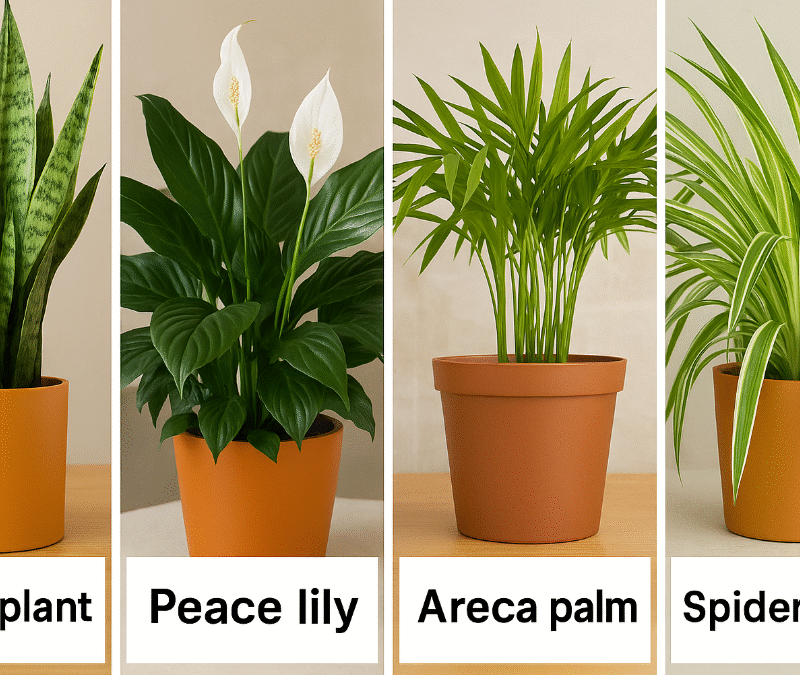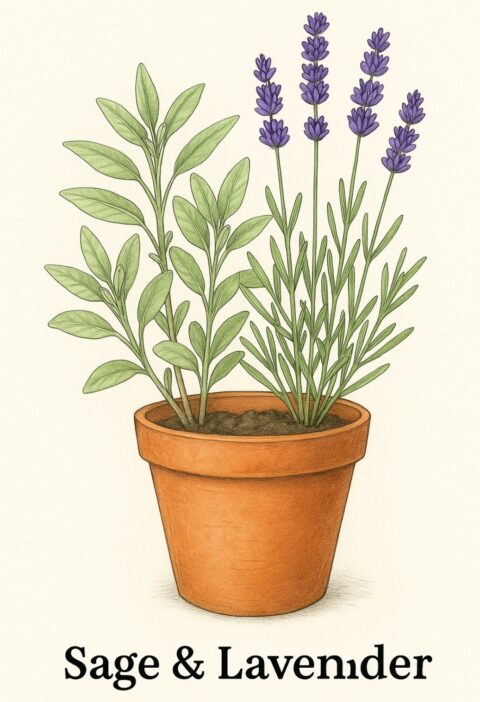🔆 6 Easy Indoor Plants That Purify Air and Brighten Your Space
Looking to transform your home into a lush, vibrant sanctuary? Indoor plants not only add a pop of green to your decor—they also cleanse the air, boost your mood, and bring life to even the darkest corners. In this comprehensive guide, we’ll dive deep into six of the easiest, most effective air-purifying houseplants you can grow, complete with expert care tips, placement ideas, and troubleshooting advice. Whether you’re a seasoned plant parent or a complete beginner, these low-maintenance beauties will have your space looking fresh and feeling healthier in no time.
🌱 1. Pothos (Devil’s Ivy)
Scientific Name: Epipremnum aureum
Common Names: Pothos, Devil’s Ivy, Golden Pothos
Why Pothos Is a Must-Have
- Thrives in low to medium light, making it perfect for offices and dim corners
- Tolerates neglect—forgets to water? Pothos hardly minds
- Proven to filter formaldehyde, benzene, xylene and other airborne toxins
Care & Maintenance
- Light: Bright, indirect or fluorescent light; avoid direct sun which can scorch leaves.
- Water: Allow the top 2 inches of soil to dry before watering; water thoroughly then let excess drain.
- Soil & Potting: Use a well-draining potting mix (peat-based with perlite). Repot every 1–2 years or when roots crowd the pot.
- Fertilizer: Feed monthly in spring and summer with a balanced, water-soluble fertilizer.
Styling & Propagation Tips
Tip: Let vines trail gracefully from a high shelf or cascading basket. The variegated leaves create visual interest against neutral walls.
Propagation: Snip a 4-inch vine cutting just below a node, remove lower leaves, and place cutting in water or directly into moist soil. Roots form in 2–4 weeks.
🎍 2. Lucky Bamboo
Scientific Name: Dracaena sanderiana
Common Names: Lucky Bamboo, Chinese Water Bamboo
Why Lucky Bamboo Belongs in Your Home
- Grows hydroponically—no soil needed!
- Symbolizes prosperity and good fortune in Feng Shui
- Adapts to low light and indoor conditions
Care & Maintenance
- Water: Use distilled or filtered water; change water every 7–10 days to prevent stagnation.
- Light: Bright, indirect light; avoid direct sunlight which can yellow stalks.
- Nutrients: Add a drop of liquid houseplant fertilizer to the water monthly; overfertilizing can burn roots.
Design & Placement
Tip: Arrange stems in an elegant spiral or braided pattern and display in a clear vase filled with polished pebbles. The visible roots add an architectural element to minimalist decor.
Propagation: Cut just below a node and replant stalks in fresh water and pebbles.
🌿 3. Snake Plant (Mother-in-Law’s Tongue)
Scientific Name: Sansevieria trifasciata
Common Names: Snake Plant, Mother-in-Law’s Tongue, Viper’s Bowstring Hemp
Top Reasons to Choose Snake Plant
- Virtually indestructible, tolerating drought and low light
- Releases oxygen at night, perfect for bedrooms
- Removes formaldehyde, benzene and other household pollutants
Care & Maintenance
- Light: Low to bright, indirect light. Can handle fluorescent office lighting.
- Water: Water sparingly—every 2–3 weeks. Overwatering leads to root rot.
- Soil: A cactus or succulent mix ensures excellent drainage.
- Temperature: Prefers 65–85°F (18–29°C); keep above 55°F (13°C).
Styling Ideas
Tip: Group different varieties (e.g., ‘Laurentii’ with yellow margins, ‘Moonshine’ with silvery leaves) in a modern planter for architectural impact. Tall varieties look stunning in corners or flanking entryways.
🌸 4. Peace Lily
Scientific Name: Spathiphyllum wallisii
Common Names: Peace Lily, White Sails, Closet Plant
Why Peace Lily Shines Indoors
- Elegant white blooms that last weeks
- Exceptional at filtering ammonia, benzene, formaldehyde
- Thrives in indirect light and humid bathrooms
Care & Maintenance
- Light: Bright, indirect light; tolerates low light but may not bloom.
- Water: Keep soil consistently moist; allow top 1 inch to dry between waterings.
- Humidity: Loves high humidity—mist leaves or use a pebble tray.
- Fertilizer: Feed monthly in spring/summer with a diluted balanced fertilizer.
Troubleshooting
Tip: Drooping leaves signal thirst—water thoroughly and the plant will perk up within hours. Yellow leaves indicate overwatering or poor drainage; repot into fresh mix if needed.
🌴 5. Areca Palm
Scientific Name: Dypsis lutescens
Common Names: Areca Palm, Butterfly Palm, Golden Cane Palm
The Tropical Appeal of Areca Palm
- Adds a lush, tropical vibe with feathery fronds
- Safe for pets and children—no toxic leaf oils
- Improves indoor humidity, ideal for dry climates
Care & Maintenance
- Light: Bright, indirect light; avoid harsh midday sun.
- Water: Keep soil evenly moist but not waterlogged; water when the top 2 inches dry.
- Humidity: Mist fronds daily or use a humidifier to prevent tip browning.
- Soil & Fertilizer: Apeat-based mix with perlite; feed bi-monthly during growing season.
Design & Placement
Tip: Pair with rattan furniture and natural fibers for a boho-chic look. Areca palms fill corners beautifully and can create natural room dividers in open-plan layouts.
🕸️ 6. Spider Plant
Scientific Name: Chlorophytum comosum
Common Names: Spider Plant, Airplane Plant, St. Bernard’s Lily
Why Spider Plant Wins Every Time
- Superb air-purifying abilities—removes carbon monoxide and xylene
- Produces baby spiderettes that are easy to propagate
- Thrives in a variety of light conditions and tolerates erratic watering
Care & Maintenance
- Light: Bright, indirect light; tolerates partial shade.
- Water: Water well, then allow the top inch of soil to dry; avoid soggy roots.
- Soil: Standard potting mix with good drainage.
- Fertilizer: Monthly feeding during spring and summer with a balanced liquid fertilizer.
Propagation & Styling
Tip: Display in hanging baskets so spiderettes cascade freely. To propagate, snip off baby plantlets and root them in water or soil.
📋 How to Choose the Right Indoor Plant
Selecting the perfect houseplant depends on your home’s conditions and your lifestyle. Consider these factors:
- Light Levels: Analyze each room’s natural light—north-facing windows offer low light, south-facing provide bright sun.
- Humidity: Bathrooms and kitchens tend to be more humid—ideal for Peace Lilies and Ferns.
- Maintenance: If you travel frequently, choose drought-tolerant plants like Snake Plant and Pothos.
- Pet & Child Safety: Verify toxicity; Areca Palm and Spider Plant are pet-safe options.
💧 General Care Guidelines for Indoor Plants
- Watering: Use the “finger test”—water only when top inch of soil is dry. Avoid overwatering to prevent root rot.
- Soil: Opt for well-draining mixes; amend heavy soils with perlite or orchid bark.
- Fertilizing: Feed actively growing plants monthly in spring/summer; hold off in fall/winter.
- Pruning: Remove yellow or brown leaves to promote healthy growth and prevent pests.
- Pest Monitoring: Inspect leaves weekly for aphids, mealybugs, spider mites; treat early with insecticidal soap or neem oil.
⚠️ Common Mistakes to Avoid
- Overwatering: The #1 cause of houseplant problems—ensure pots have drainage holes.
- Poor Light Placement: Placing a low-light plant in direct sun can scorch leaves, while sun-loving species in shade will stretch and weaken.
- Ignoring Humidity: Dry winter air can cause crispy leaf tips—mist regularly or use a humidifier.
- Infrequent Repotting: Crowded roots lead to slowed growth—repot every 1–2 years.
🌿 Benefits of Indoor Plants for Your Health & Home
- Air Purification: Plants remove VOCs like benzene, formaldehyde, and trichloroethylene, improving indoor air quality.
- Stress Reduction: Studies show interacting with plants lowers cortisol levels and promotes calm.
- Increased Humidity: Transpiration from leaves adds moisture to dry environments, helping respiratory health.
- Boosted Productivity: Greenery in workspaces can increase focus and creativity by up to 15%.
🔎 Frequently Asked Questions (FAQs)
Q1: Which indoor plant is best for purifying air?
A: Spider Plant and Peace Lily are top air-purifiers according to NASA studies, removing carbon monoxide, benzene, and trichloroethylene.
Q2: How often should I water my Pothos?
A: Water when the top 2 inches of soil are dry—typically every 1–2 weeks, depending on your home’s humidity and temperature.
Q3: Can Snake Plants tolerate low light?
A: Yes—Snake Plants thrive in low to bright, indirect light, making them perfect for offices and bedrooms.
Q4: Why are my Peace Lily leaves turning brown?
A: Brown tips often indicate low humidity or under-watering. Increase misting or place the plant on a pebble tray with water.
Q5: How do I propagate Lucky Bamboo?
A: Cut just below a node and place the stalk in fresh, distilled water with pebbles for support. Roots develop in 2–3 weeks.
Q6: Are Areca Palms safe for pets?
A: Absolutely—Areca Palms are non-toxic to cats and dogs, making them ideal for family homes.
Q7: What humidity level do indoor plants need?
A: Most tropical houseplants prefer 40–60% humidity. Use a hygrometer to monitor and mist or humidify when levels drop below 30%.
Q8: How do I prevent root rot?
A: Ensure pots have drainage holes, use well-draining soil mixes, and avoid letting plants sit in water.
Q9: Can indoor plants improve my sleep?
A: Yes—plants like Snake Plant release oxygen at night and help filter air, which can promote better sleep quality.
Q10: Where can I find more indoor gardening tips?
A: Explore our related guides at CanadianEdShop for expert advice on organic air purifiers, DIY cleaners, and natural home remedies.
🔗 Related Articles (Internal Linking)
- How to Make Organic Air Purifiers at Home
- 4 Homemade Natural Insect Sprays to Safely Banish Ants, Roaches, Bed Bugs & Mosquitoes
- DIY Organic Cleaners for a Chemical-Free Home
- Surprising Uses & Benefits of Vinegar Around the House
- Natural Home Remedies: Kitchen Ingredients That Heal
🌟 Conclusion: Bring Nature Indoors for Health & Happiness
These six easy-care indoor plants not only enhance your decor with lush greenery but also improve air quality, boost your well-being, and create a tranquil atmosphere. From the trailing elegance of Pothos to the sculptural beauty of Lucky Bamboo, there’s an air-purifying hero for every space and skill level. By following the care guidelines and placement tips above, you’ll enjoy healthier air, reduced stress, and a more inviting home environment. Ready to start? Choose your favorites, grab a pot, and let’s cultivate a greener, brighter indoor oasis together!






